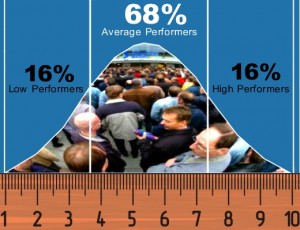Finding Top Talent Among Majority Of Average Performers
May 15, 2012 by Gary Birshtein· Leave a Comment
 Research shows that a population of job seekers is divided into three distinct categories – high (or top) performers, low (or bottom) performers and average performers.
Research shows that a population of job seekers is divided into three distinct categories – high (or top) performers, low (or bottom) performers and average performers.
This is probably no surprise to many employers. We have all seen some top achievers, a few people that were not capable at all and many people who were just OK. The thing is that those “OK” people represent 68% of the population.
To put this in perspective, this is what it looks like:
Average performers represent 68% of the population.
High performers represent 16% of the population.
Low performers represent 16% of the population.
Because nobody really wants to hire low performers, high performers are hard to find and the majority (68%) of job applicants are going to be in the “average” category. So the challenge for employers is going to be finding better performing employees among the average category.
Take another look at the image above. Let’s assume that 1-2-3 represents low-performing employees and 8-9-10 represents high performers. So how can you recognize and choose the “7” over the “4” when you’re dealing with a majority of average performers? Or – think about this one – how you can know for sure someone who appears to be “8” or “9” is not actually “3” or “4”?
It’s all going to come down to measuring talent, filtering out non-talent and finding the right job fit.
As we all know, a good office manager doesn’t necessary make a good salesperson but could possibly make a good bookkeeper. But how do you know that for sure, especially when you’re dealing with a total stranger? How can you really know anything about him?
The answer is gathering relevant information combined with interviews and reference checks, each representing about a third of your decision-making process.
Unless you employ private detectives and behavioral psychologists and use lie detectors as part of your hiring strategies, it’s impossible to make educated hiring decisions that are based on relevant information – that is, information strictly related to the interviewee.
But who has that kind of money to spend on hiring someone for $30-50,000 – or even a bit higher – salary? I don’t know. Maybe some people do. I do know, though, that on average recruitment agencies charge 15% of annual salary for finding employees. And 15% of $50,000 is $7,500. I bet I could hire private detectives and behavioral psychologists to sit in on a few interviews for that kind of money.
But to be realistic, and most efficient, there is absolutely no need for such expense of time and money. Try to remember and understand the following: “If we can measure it, we can manage it.” Say it again, out loud this time: “If we can measure it, we can manage it.”
In other words, if you can measure it you can understand it. We don’t often realize that we constantly employ measurement systems in our daily life: shoe sizes, vehicle speeds, food recipes, etc. And what would happen if we use wrong measurements? The answer is obvious.
The ideal and the most cost-effective solution ($50-$150 per person) for employers is to implement skills testing in combination with behavioral assessments.
By doing, so they’ll be able to assess the job fit and understand things like dependability, concentration, initiative, self-discipline, trainability, communication and reaction to criticism to name a few. And they can also assess proficiencies in specific areas such as Microsoft Office, typing, grammar, etc.
Today’s technology is able to offer a variety of online tools to help employers minimize hiring cost, decrease turnover and increase productivity simply by making better and more efficient hiring decisions.

